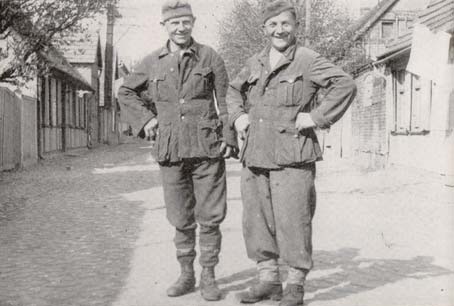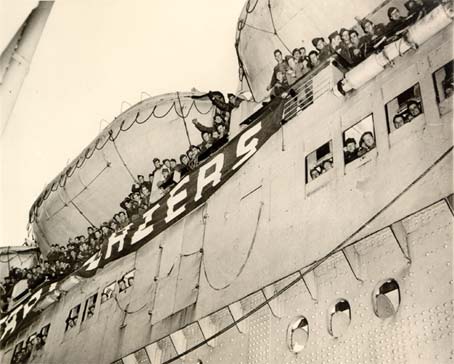| |
VE Day to December 7, 1945
On May 7, 1945, at the Red School
House in Rheims, France, the German High Command’s representatives,
Gen. Jodl and Admiral Von Friedeburg, having been there since
arriving at 5:30 p.m. the day before to argue the German position
that they were surrendering only on the Western front and
not on the Eastern front, finally had conceded and signed
the surrender documents which called for a complete cessation
of all hostilities on May 8, at 11:01 p.m.
The news of the unconditional surrender, by agreement of
Churchill, Truman and Stalin, was not to be released to the
public until 3:00 p.m., London time on May 8th (9. a.m., Washington
time). A frustrating delay to the attending reporters and
indeed to Churchill himself who wanted to break the news immediately
as crowds gathered in London anticipating the announcement.
Pent up emotions exploded in Europe. Riotous celebrations
broke out. Londoners and Parisians realized the war was finally
over. Bonfires, ship whistles, rockets streaking, frenzied
masses of dancing, cheering people snaking through the street
as VE Day was announced for the following day, May 9th –
but the celebration was already in full swing.

Our war is over
In New York, there was also celebration but more tempered
as Americans, while excited, knew that there was still a war
to be won in the Pacific. Among American troops there was
joy and relief, both jubilation and soberness. Perhaps most
felt a vast relief over still being alive, the prospects of
being able to think about going home, and the emerging realization
that there would finally be a future out there somewhere after
all.
Some of the 35th Division soldiers paraded through the ruins
of Hanover and perceived a welcome relief even in the faces
of the German observers. The Division Headquarters was at
Dohren, just outside of Hanover, and all were now enjoying
the freshness and beauty of Spring as the troops continued
their assigned duties of occupation in the surrounding neighborhoods.
Some officers were sent to I and E (Information and Education)
schools to help in the adjustment of troops to the post hostilities
era. Some discussion centered around the war in the Pacific
and the need for troops to be sent to the Pacific theatre
to participate in the coming invasion of the Japanese Islands.
There was speculation that the 35th Division might go.
Ten days later, on May 17th, the British Army and the 84th
U.S. Infantry Division began the relief of the 35th Division
in the Hanover area and we moved by truck to Recklinghausen,
Germany, in the Munster sector for eleven days, moving once
again after turning this sector over to the British on Memorial
Day, May 30th, as this part of Germany was to become a part
of the permanent British occupation zone. During June 1st
to the 4th, we moved by motor and by rail to the 15th Army
zone, to Koblenz and along the Rhine River, relieving the
66th U.S. Infantry Division, taking over their governmental
and occupational duties. We were to remain there until July
10th.
This, it would develop, would be the last tour of duty for
the entire division as a unit. We learned that, as anticipated,
the division had been selected for the Pacific War area and
we began the process of making the choice, either to remain
in the Army and go with the division, or to join with the
high point men, those with the longest service who would elect
to go home and resume their civilian lives. Gradually the
division would begin to bid goodbye to many of the old timers
who were transferred to the 75th Division and other units.
New low point men and volunteers for the Pacific were welcomed
into the division to fill the gaps in the ranks. It was not
a happy time, and buddies parted company reluctantly.
One of the highlights of our stay on the Rhine was the re-dedication
of the Sante Fe Stadium in Koblenz, originally built in 1919
by the 35th Division during the First World War. Two battalions,
one of them the 1st battalion of the 320th Infantry Regiment,
were presented the Presidential Unit Citation Award for heroism
at Mortain in July, 1944, in breaking through the German lines
and rescuing the “lost” battalion of the 30th
Division which had been cut off by the German Panzer counter
offensive. Another thrill was to see our outstanding baseball
team beat the team of the 106th Division later in the day
in the same stadium.
On July 10, 1945, the 35th Division was relieved all along
the Rhine River by the 10th French Infantry Division, as this
was to be a part of the permanent occupation by the French.
This was the first movement by the division to go to the Pacific.
Our 137th Infantry Regiment was selected for a signal honor,
that of furnishing the Honor Guard for President Harry Truman
in Brussels en route to the Potsdam Conference. The President
had been a captain with the 129th Field Artillery, part of
the 35th Division in France in 1918 and he had looked forward
to meeting and talking with members of his old division. It
was a mutually gratifying experience for both Truman and the
men of the 137th! The regiment was stationed at Griberges,
just outside of Brussels at a camp called “White Tie”,
and remained there until August 23rd.
The remainder of the division moved on July 10th to Camp
Norfolk, a tent camp near Sommesous, France, not far from
Rheims. The shifting of men in and out of the division continued.
August 14, 1945 was a fateful day. It brought the news of
the Japanese surrender and VJ Day which ended the war in the
Pacific. But it did not stop the pending return of the division
to the States and on the next day the division, minus the
137th Regiment moved to Le Havre and boarded the SS Marine
Wolfe, sailing to South Hampton, England, where it disembarked
and moved to Tidworth Barracks to await HMT Queen Mary. The
Queen Mary was the third largest passenger liner afloat and
the holder of the trans Atlantic crossing record. On September
5th the ship was ready to be loaded and departed from South
Hampton on the same day, arriving in New York Harbor on September
10th to a suitable reception complete with welcoming band
music. Taken immediately to Camp Kilmer, New Jersey, all personnel
were given 30-45 day recuperation furloughs, after which they
were ordered to assemble at Camp Breckinridge, KY.
The 137th Regiment in the meantime also was ordered to leave
Camp White Tie on August 23, and report to Le Havre where
they boarded the MS Cristobal and set sail on a direct route
to Boston Harbor, arriving there on August 31st. The regiment
was immediately sent to Camp Myles Standish, just outside
of Boston where the men and officers were given the same furloughs
and orders to report to Camp Breckinridge as the rest of the
division.
At the termination of the furloughs the division assembled
as ordered and immediately began the processing and discharging
of high point men to their homes, as directed by Army policy
at that time, men with low point scores were sent to existing
units for further service. Many of the high point men formerly
in the division and left behind in Europe did not arrive in
the United States until later in December and through the
winter months!

The S.S. Queen Mary with 35th Division
banner.
On December 7th, 1945, four years after Pearl Harbor Day,
the remnant left of the division, watched the flag lowered
as the 35th Division was formally mustered out of service
as a unit in the United States Army.
Thus closed the epic of one of America’s finest infantry
forces, the Sante Fe division, maintaining and enhancing the
highest traditions of the citizen soldier, and fostering pride
in the memories of our great crusade among all who have served!
 More
about The Final Days More
about The Final Days
|